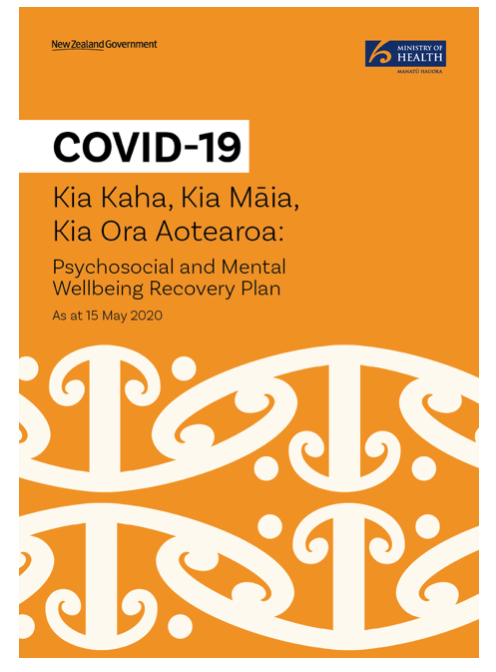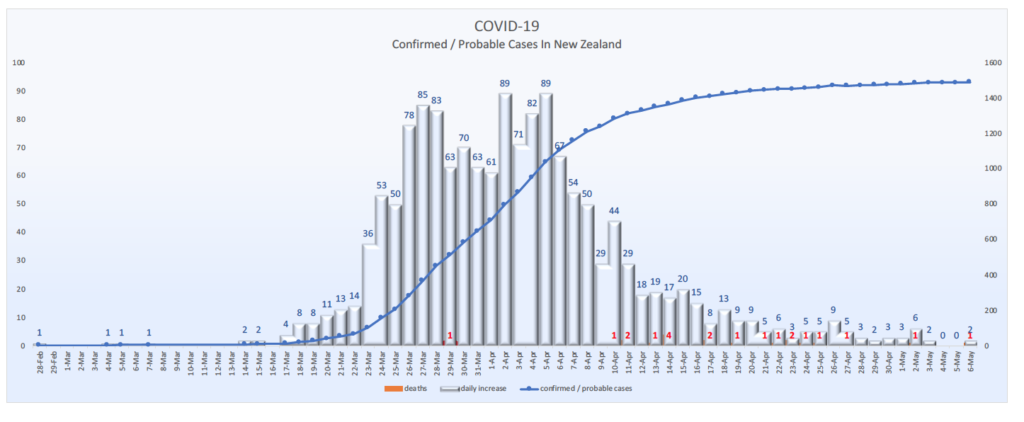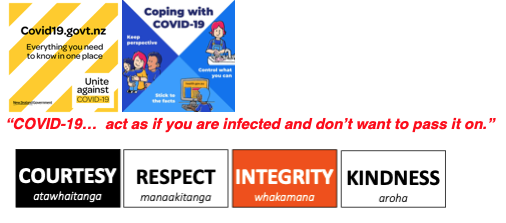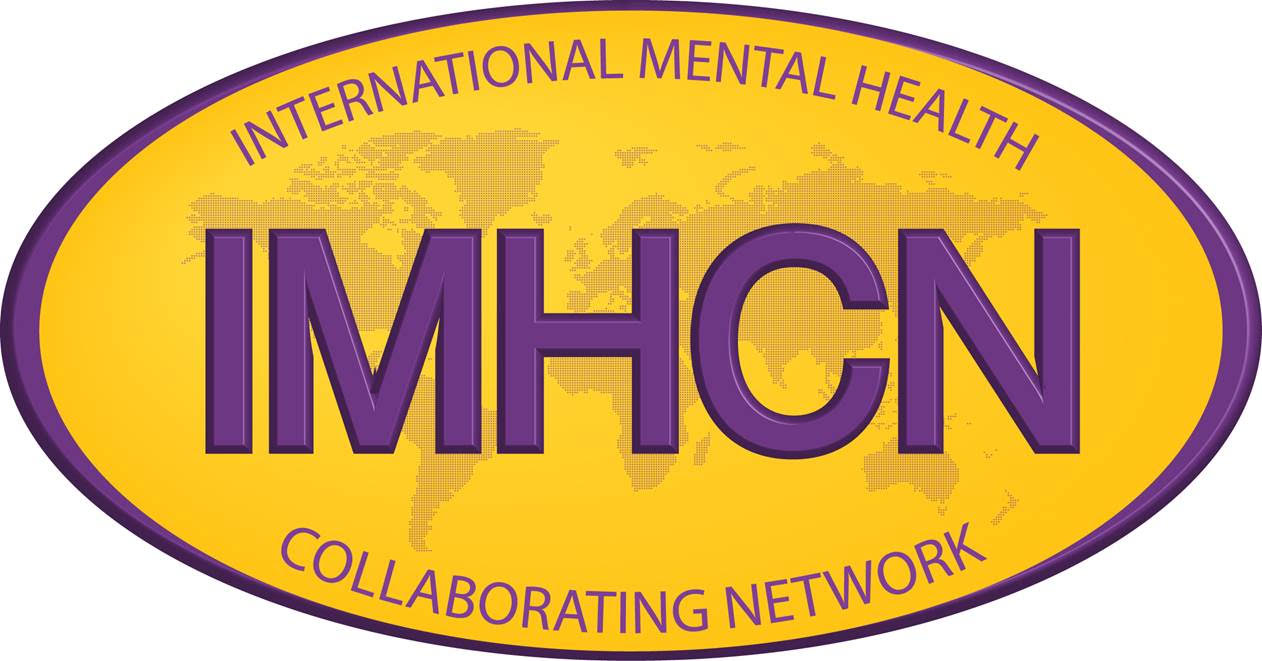Report by Rob Warriner

KIA KAHA, KIA māIA, KIA ORA AOTEAROA: COVID19 PSYCHOSOCIAL AND MENTAL WELLBEING RECOVERY PLAN FOR NEW ZEALAND
Update 20th May 2020: First draft of a National Mental Health Plan has been developed by the New Zealand Ministry of Health. See executive summary below:
Executive Summary
"The COVID19 pandemic has placed significant restrictions on all New Zealanders and has changed the lives of many whānau and communities in New Zealand.
Distress is common and a normal reaction to disruption and uncertainty. It is likely that communities and whānau will experience a range of responses and severity of distress. Most people will recover with support and time.
As with the pandemic response, New Zealand’s psychosocial response must also act early to prevent an increase in mental distress and further negative consequences for whānau and communities. Prevention and early intervention are key to enhancing mental wellbeing after lives have been disrupted by the pandemic.
Psychosocial support focuses on ensuring that the mental and social wellbeing needs of whānau and communities are met, and they are supported to recover, adapt and thrive despite challenges and disruption. Psychosocial support spans a wide range of both mental health and social interventions: from ensuring whānau and communities have clear information, basic needs and community connection, through to delivering specialist mental health and addiction services for people who have or develop significant mental distress, substance use or gambling harm.
The goal of the recovery framework is to protect and enhance people’s mental wellbeing so that they can adapt and thrive after their lives have been disrupted by the COVID19 pandemic. It has been designed to guide a coordinated effort across national, regional and local levels to support wellbeing. As the lead agency for psychosocial recovery, the Ministry of Health is responsible for leading and coordinating mental and social wellbeing support (psychosocial support) in emergencies, so many of the plans’ actions are for the Ministry.
We recognise, however, that many of the influences on health and wellbeing are outside of the health sector. This plan will only succeed with a shared vision for a thriving and equitable New Zealand and a willingness for collective action to support the communities we serve. The Ministry is committed to fostering and developing partnerships that aim to prevent and minimise the wide-reaching impacts that COVID19 and related stressors may have on our mental and social wellbeing.
The psychosocial response to COVID19, and the subsequent recovery phase, provide an opportunity to further pursue the vision of He Ara Oranga: Report of the Government Inquiry into Mental Health and Addiction and the Government’s response. The Ministry began its work in response to He Ara Oranga prior to the pandemic, particularly through investment in primary, community and wellbeing support, and growing the workforce. In responding to COVID19, this work becomes even more vital.
Working together, we can foster protective factors that build the resilience of whānau and communities and grow all New Zealanders’ ability to strengthen their responses to distressing times.
This plan has been developed based on six guiding principles: People and whānau centred, community-led, uphold Te Tiriti o Waitangi, achieve equity, protect human rights and work together. These principles guide five focus areas for action, which are to:
collectively build the social and economic foundations for psychosocial and economic wellbeing
empower community-led solutions
equip people to look after their own mental wellbeing
strengthen mental health and addiction supports in communities
support specialist mental health and addiction services.
This plan is intended to guide actions for the next 12–18 months, but we recognise that recovery and adapting to a new reality is likely to take several years. The actions have been developed on an understanding that our response and actions must evolve to reflect emerging needs and evidence, but our overarching framework and guiding principles will remain constant."
Status Report 8th May from Rob Warriner - Chief Executive, WALSH Trust, New Zealand
In New Zealand we registered our first infection on 28 February; this had increased to 51 on 29 March when we experienced our first death from COVID-19. (To place these number in context, the New Zealand population is 4,860,000 people).
On 21 March, the Government announced the introduced of 4 COVID-19 Alert Levels; each would invoke different levels of restrictions. At that time were advised that we were at Level 2. This was raised to Alert Level 3 on 23 March with advice that at 11.59pm on 25 March New Zealand would be put into Alert Level 4. New Zealand was completely “locked down”; only essential services were able to operate.
The Alert Level came back to Level 3 on 28 April. This partially lifted some lockdown restrictions. The Government is to announce on 12 May whether or not we will move to Level 2 which, it is anticipated will place far more emphasis on safety and containment and will include a significant easing of restrictions.
At time of writing, from a peak of 89 new infections in a day (a total of 1,490 infections), in the last few days daily infections have dropped to between 0 and 2. A total of 21 people have died from COVID-19.

While the lengthy lockdown period has placed enormous demands and terrible impositions on people (eg. restrictions on people attending births and deaths – has led to some very sad stories…), the goal of “flattening the curve in the graph of infections has been successful to the point if elimination of COVID-19. The population in general has cooperated with Government in general with Government measures. I would identify two reasons for this.
1) communication – and very human communication. Virtually every day, at 1.00pm the Prime Minister, alongside the Director-General of Health held a briefing / press conference where they announced latest data / information regarding infections and deaths, and answered questions from press. Both were also active on Facebook forums. The Prime Minister addressed children’s concerns through the lockdown that encompassed Easter. She assured children at the press conference that the Easter Bunny was an essential worker and to expect chocolate Easter eggs as per normal.
2) Whānaungatanga. This is a Māori concept. It speaks of the importance of
relationship, kinship, sense of connection through shared experiences and working together that provides people with a sense of belonging. With these come a collective sense of rights and obligations. It also easily extends to others to whom one develops a close family / whānau, friendship or reciprocal relationship.
Through whānaungatanga people are able to more easily recognise shared interest and/or connection, obligations and commitments. While New Zealand may not loudly represent or exhibit traditional European patriotism as a glue to form the nation, whanaungatanga represents a more human and grounded shared
connection.
The economy has been terribly damaged and will impact people and communities for time to come through unemployment, loss of income, potential loss of housing, leading to what has been described as the next pandemic being one of mental ill-health and distress. Of concern to me is that mental health services struggled to respond to demand prior to COVID-19; mental health services will struggle even more post the COVID-19 lockdown – even more so as the modus operandi remains one of passive, hospital / clinic based services that waits for people to arrive / present themselves.
With regards to my own organisation we have continued to provide services; principally remotely by phone / video call. We have ensured all clients have the use of a mobile / smart phone. We have consequently accessed video training for our staff in providing better phone support, where the phone is the principle source of contact and support, rather than a “back up”. This has been invaluable.
All our staff are equipped with iPads and smart phones. They are now far more familiar and comfortable in making good and full use of these. The more confident use of technology has been one the principles learnings for staff – as well as getting feedback from staff as tomhow technology can changed / adapted to be even more useful.
Access to food / supermarkets has the been the most common requirement for face to facecontacts. A number of staff have delivered hundreds of food parcels to people in the last 4 weeks.
We have also supported (and where necessary paid for) all people using our services to receive a flu vaccination. For our staff we have offered “mindfulness” and Tai Chi classes – always remotely.
The changes in practice – and particularly the number of people who have requested that we not contact / visit them during the lockdown period, has caused us to begin examining the nature and content of services we traditionally offer; are these still relevant? Has it become more important for us to provide services than it is for people to receive them?
How do we ensure our services remain relevant, adaptable and nimble to respond to developing needs for support and assistance?
We are promoting a sense of optimism. My weekly newsletter / update to staff is titled “Business as usual – but different”. Rather than referring to “back to normal” we speak of moving “forward to normal”. Influencing and shaping a new normal a new future, is now a core focus of leadership discussions.

Rob Warriner, 8 May, 2020
